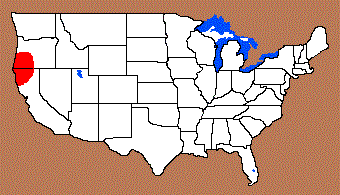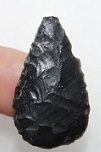Outline is Representative of Size and Shape:

Name Details:
Identified By: Luther S. Cressman
Named For: Type Site
Date Identified: 1933
Type Site: Gold Hill Site (on the Rouge River), Jackson county, Oregon
Identified By: Luther S. Cressman
Named For: Type Site
Date Identified: 1933
Type Site: Gold Hill Site (on the Rouge River), Jackson county, Oregon
Point Validity:
Valid type
Cressman was a sociology and anthropologist who started as a Professor of Sociology at the University of Oregon and went on to found the Department of Anthropology. He is most noted for his excavations of Paleo sites such as Fort Rock and Paisley Caves. This type was named in a professional publication and has many professional references. This is considered a valid type.
Cressman was a sociology and anthropologist who started as a Professor of Sociology at the University of Oregon and went on to found the Department of Anthropology. He is most noted for his excavations of Paleo sites such as Fort Rock and Paisley Caves. This type was named in a professional publication and has many professional references. This is considered a valid type.
Gold Hill Ovoid
Cluster: Description of Physical Characteristics and Flaking Pattern:
This is a thick small to medium (.9 to 1.4 inches) ovoid point with an elliptical cross section. The blade is excurvate with the tip curving in, becoming widest at one third to one half of the blade, and curving back in towards the base. The base is convex. This point has a random flaking pattern.
Size Measurements:
Length - 24 to 35mm (Mean 29.7mm), Width - 12 to 16mm (Mean 14.3mm), Thickness 4 to 7mm (Mean 5.5mm)
Length - 24 to 35mm (Mean 29.7mm), Width - 12 to 16mm (Mean 14.3mm), Thickness 4 to 7mm (Mean 5.5mm)
Additional Comments:
This type is similar to the Malaga Cove, Excelsior, and McKee Uni-face, but Justice (2002) feels that these all represent distinct types because even though all of these type employ pressure flaking techniques, there is a difference in the overall size, shape, flake removal patterns of each type.
This type is similar to the Malaga Cove, Excelsior, and McKee Uni-face, but Justice (2002) feels that these all represent distinct types because even though all of these type employ pressure flaking techniques, there is a difference in the overall size, shape, flake removal patterns of each type.
Distribution:
Distribution Comments:
This point is primarily found in the Rouge River Valley of Oregon and into northern California extending to the coastal regions of southern Oregon and Northern California.
This point is primarily found in the Rouge River Valley of Oregon and into northern California extending to the coastal regions of southern Oregon and Northern California.
Age / Periods:
Date: 4,000 - 2,000 B.P.
Cultural Period: Late to Transitional Archaic
Glacial Period: Neoglacial to Roman Warm
Culture:
Date: 4,000 - 2,000 B.P.
Cultural Period: Late to Transitional Archaic
Glacial Period: Neoglacial to Roman Warm
Culture:
Age Details:
These points were found in the middle to upper strata of the Klamath Shoal Midden at the Gold Hill site.
These points were found in the middle to upper strata of the Klamath Shoal Midden at the Gold Hill site.
Other points in this cluster / Related / Associated Points:



